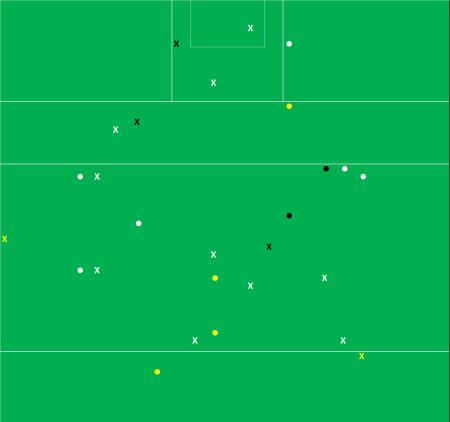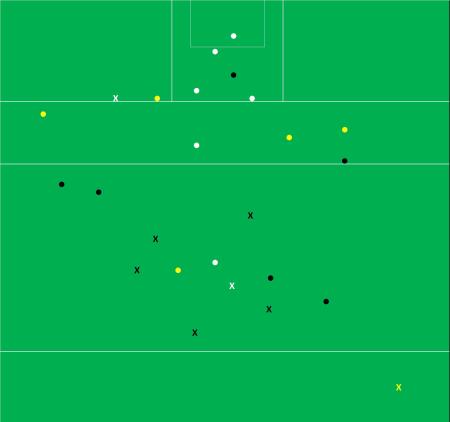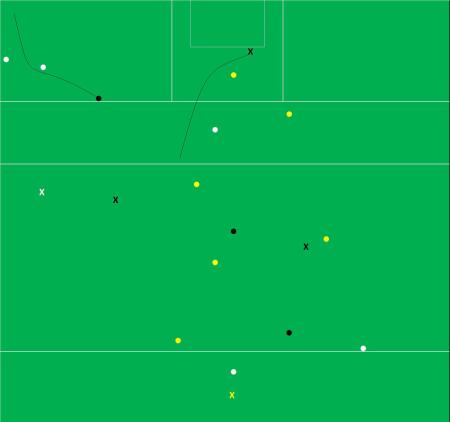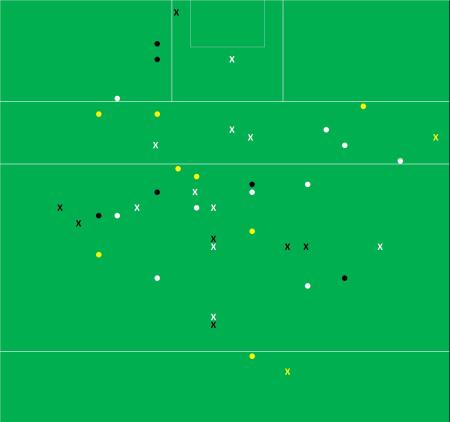For those new to the blog, or who haven’t been here for a while, please find a refresher on the definitions and how the numbers are compiled here
Overall
| Team | Possessions | Shots | Shot Rate | Scores | Success Rate | Weighting |
| Donegal | 34 | 26 | 76% | 12 | 46% | -0.246 |
| Kerry | 42 | 33 | 79% | 11 | 33% | -4.361 |
| Champ (’12 & ’13 avg 70 mins) | 35.8 | 27.6 | 77.2% | 14.1 | 51.0% |
Volume, and goals, trump accuracy.
As we will discuss below Kerry’s point taking was very poor (not that they will care now!) but their ability to carve out goal chances (or be granted them) and convert those chances saw them through. They had four attempts at goal scoring 2-01. Donegal had three, including two in that last minute scramble, and scored nothing.
So perhaps more accurately it was Kerry’s goal shot accuracy that trumped Donegal’s point taking efficiency.
Where attacks originated
| Opposition k/out | Own k/out | Ball received in Own 3rd | Ball received in Mid 3rd | Ball received in Opposition 3rd | Other (throw-in, rebound etc.) | |
| Donegal | 7 | 11 | 14 | 1 | 0 | 1 |
| Kerry | 8 | 10 | 15 | 3 | 0 | 6 |
This was the one area that stood out to me whilst watching the game. The majority of categories in the above table are quite similar. Attacking possessions originating from kickouts were the same whilst Kerry slightly edged the attacks from turnovers. Nothing that would definitively swing a game either way. But then there was the “other” category.
On four separate occasions Kerry regained the ball after one of their shots went astray. Three times they scored from these. It is almost like the “hidden yards” that NFL teams gain from their special team units. Unseen, unglamorous work that reaps huge benefits.
Think of Kerry’s initial burst – P Geaney plucked O’Brien’s skied shot from the air for his goal. He again reacted first to Buckley’s blocked shot to knock the ball down to O’Donoghue in space for an easy point. Nothing spectacular but both scores could easily have been nullified. On the other side Donegal only once created an attack from a shot and that was the last play of the game when McFadden fisted McBrearty’s blocked shot onto the post.
Shots from Play
| Team | Shots | Scores | Success Rate | Weighting |
| Donegal | 20 | 8 | 40% | +0.351 |
| Kerry | 27 | 7 | 26% | -4.232 |
| Champ avgs (’12 & ’13 70 mins) | 20.3 | 9.2 | 45.4% |
Kerry had four shots at goal scoring 2-01.Although one of those shots was laid on a plate that is still not an insignificant achievement. The volume of goal shots allowed by Donegal this year was 1, 0, 2, 1 & 5 (vs the Dublin goal machine). In fact the only other teams to produce more than three goal shots since the start of 2012 are the aforementioned Dublin and Mayo in the 2013 quarter final rout.
Of course if Kerry hit 75% on their goal shots their point taking must have been atrocious. And it was. They converted 17% (4 from 23) of their attempts with a weighting of -5.603. They had 16 attempts at a shot from what might be considered outside the scoring zone and converted two (Murphy’s sublime effort from the right and Buckley late on from the left). Two! This from a team that had converted 57% of all point attempts in the run up to the final.
Some of that lack of accuracy can be applied to Donegal. They applied pressure to 63% (10/16) of those shots outside the scoring zone. Indeed excluding Johnny Buckley, who had the knack for finding pockets of space – he managed to take three shots with no pressure – Donegal pressured 77% of those more difficult opportunities. On top of that Donegal restricted O’Donoghue to one shot. Goals, and goals from individual errors, are a killer.
Donegal were much more efficient than Kerry but that isn’t saying much. They were still below average.
They only managed 5 shots from play in the first half with the first not arriving until the 24th minute when O’Connor’s goal attempt was saved. They were much better in the second half, managing 13 shots for a point but again their accuracy was nowhere where it needed to be. They converted 46% (6/13) but really, off such a low base, they needed to be in the high 60 percentile to catch up with Kerry’s goals.
Again we have to credit the opposition’s defence here. Kerry were stout not allowing Donegal a goal shot in that second half until the last minute scramble. They did this without fouling either – as noted below they didn’t concede one foul inside the 45 during the second half whilst also pressuring 69% (9/13) of Donegal’s point attempts.
Shots from deadballs
| Player | Shots | Scores | Success Rate | Weighting |
| BJ Keane (Kerry) | 2 | 2 | 100% | +0.313 |
| B Sheehan (Kerry) | 2 | 1 | 50% | -0.028 |
| P Geaney (Kerry) | 1 | 1 | 100% | +0.087 |
| D Moran (Kerry) | 1 | 0 | 0% | -0.500 |
| M Murphy (Donegal) | 5 | 3 | 60% | +0.019 |
| C McFadden (Donegal) | 1 | 1 | 100% | +0.087 |
| team avgs (’12 & ’13 Champ) | 7.3 | 4.9 | 66.7% |
Both team’s free taking was essentially average although both Sheehan (the late free from the right sideline) and Murphy (a sideline attempt in the first half) both had one attempt with a ridiculous degree of difficulty. The rest of the deadballs graded out as expected with the four shared by McFadden, BJ Keane & P Geaney all relatively close to goal.
Kerry’s defensive discipline – or lack thereof – was giving Donegal an easy out in the first twenty minutes. Donegal had five attempts from deadballs, converting four (the aforementioned sideline attempt being the only miss), before they had a shot from play. But that changed in the second half with Donegal only having one attempt from a free and that occurred outside the 45.
A quick note on Brian Sheehan’s free towards the end. I have, on more than one occasion, been concerned by Kerry’s inconsistency in free taking but the old adage of “form being temporary and class permanent” was never more apt. To come off the bench and deliver that strike was simply brilliant.
Turnovers
| Team “coughing up” possession | Volume | Shots from Turnovers | % |
| Donegal | 23 | 13 | 57% |
| Kerry | 20 | 9 | 45% |
| Misplaced Pass | Tackled | Shots not going dead | Other | |
| Donegal | 8 | 4 | 6 | 5 |
| Kerry | 6 | 6 | 6 | 2 |
A relatively low turnover count with possession being key. Indeed Donegal went over six minutes, from Christy Toye’s point in the 65th minutes, without having possession of the ball outside of Durcan’s kickouts.
Such was Kerry’s discipline & control I only tagged them for six turnovers in the entire second half – and one of those was Moran’s shot that hit the post.
Kickouts
| Donegal’s kickouts | Won | % | Turned into a possession | % | Shot | % |
| Donegal | 15 | 63% | 11 | 73% | 11 | 73% |
| Kerry | 9 | 38% | 8 | 89% | 7 | 78% |
| Kerry’s kickouts | Won | % | Turned into a possession | % | Shot | % |
| Donegal | 8 | 42% | 7 | 88% | 5 | 63% |
| Kerry | 11 | 58% | 10 | 91% | 9 | 82% |
The overall numbers look very similar. Of course this depends on viewing the pivotal turning point in the second half, Durcan’s short kick to Donaghy, as just another score. It was much more than that.
When you are a short kickout team giving the opposition the ball in a very attacking position is an occupational hazard. It is however rare. On 28 short kickouts in the previous five Championship games the opposition only gained the ball twice from Donegal short kickouts and didn’t get a score either time.
It was not as if the Donegal kickout wasn’t working. Before the Donaghy goal Donegal had taken nine short kickouts and scored 0-04 from those possessions. None of the kickout recipients were under pressure when receiving the ball. Six further kickouts had gone past the 45 with the possession battle being 3-3. Donegal were unable to get the ball to players past the 45 in space but they were still being productive. That was until the Donaghy goal.
Not only did the error cough up the goal but it spooked the team as well. Immediately after the goal Donegal kicked the next four kickouts long. Kerry won all four scoring 0-02.
Of Kerry’s 19 kickouts five went short with Kerry gaining possession each time. When the ball went past the 45 Donegal won the possession battle 8-6.
Shot Charts
Kerry’s shooting

x = missed, disc = score, yellow = deadball, black = 1st half from play, white = 2nd half from play,
Players with >= 2 shots from play
| Shots | Scores | Success Rate | Weighting | |
| P Geaney (Kerry) | 7 | 2 | 29% | -0.743 |
| P McBrearty (Donegal) | 5 | 2 | 40% | -0.251 |
| K Donaghy (Kerry) | 4 | 3 | 75% | +0.817 |
| J Buckley (Kerry) | 3 | 1 | 33% | -0.078 |
| M Murphy (Donegal) | 2 | 1 | 50% | +0.282 |
| K Lacey (Donegal) | 2 | 1 | 50% | +0.224 |
| O MacNiallais (Donegal) | 2 | 1 | 50% | +0.142 |
| D Moran (Kerry) | 2 | 0 | 0% | -0.719 |
| D Walsh (Kerry) | 2 | 0 | 0% | -0.719 |
| A Maher (Kerry) | 2 | 0 | 0% | -0.858 |
| M Geaney (Kerry) | 2 | 0 | 0% | -0.858 |
| C McFadden (Donegal) | 2 | 0 | 0% | -0.906 |



















